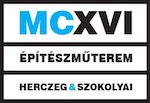| Location | Lendava, Slovenia |
| Client | Ministry of Foreign Affairs and Trade |
| Floor area | 500 m2 |
| Architecture | DMB műterem Kft. |
| Architect designers | Balázs Falvai DLA, Márton Nagy DLA, Dávid Török DLA, Ábel Györgyi, Bence Grócz |
| Interior designer | MCXVI Architects |
| Leading interior designer | Gábor Szokolyai |
| Interior designers | Katalin Imre, Anna Szuhányi, Zsófia Paál |
| Status | Completed |
| Project year | 2018 |
| Photography | Antal Bánhegyesy, Gáspár Hajdu |
In the absence of the original plans and archival photos of the building, the site excavations were of great importance. This revealed, among other things, that beautiful wall paintings were hidden under last layers of paint. We wanted to bring these back to life. The patterns and colours were reconstructed with great care by the restorer painters.
We took the building’s ability to strengthen identity seriously. Therefore, the antique furniture was purchased in the local neighbourhood. Enlarged photos of the records of the savings bank’s member assembly were brought back to the house as wall graphics. We also thought that the safe, marked with the Hungarian coat of arms, should be preserved during time of the restoration and housed in the new building. The safe may have stayed here from the savings bank. Only one piece of the original tile stove was found in the attic which served as the starting point for rebuilding the stove.
The building is not a national monument, but we still preserved its treasured and retraceable values. At the same time, the consulate general must operate in a way that suits today’s needs. There was a need to both show functionally and visually the inclusive openness and order of the bureau. The different elements, spaces and surfaces of the house were designed in a sort of hierarchy. In the set of the rooms closest to the street front, we chose the solutions that most preserve the original intentions and ornaments. In the tract by the courtyard, simple functional principles dominated without any particular visual emphasis.
The history of the building (from the architect’s description)
“The first sixty years of the building’s history, until 1945, is closely interwoven with the history of the Lower Lendava Savings Bank. The headquarters of financial institutions were one of the typical new building types of the progressive era, following the Austro-Hungarian Compromise of 1867. The building of the Lower Lendava Savings Bank is a typical example of this. The foundation of the Savings Bank was initiated by Mihály Kakasdi Hajós, a lawyer. He organized the wealthy citizens of the town, and in March 1873, the founding meeting was held in the room of the Nagyvendéglő’s Citizen’s Reading Hall. The Lower Lendava Savings Bank started operating after the approval of the Ministry of Finance on 26 April 1873. The founders set their initial capital at 40.000 HUF. Its CEO was Vincze Zárjeczky and its chairman was Ödön Lenck. Initially, the savings bank was located in the Nagyvendéglő, the building of the later Hotel Korona. The HUF 100 shares issued by the savings bank were immediately taken. The financial institution was so successful that a decade later, from 1882 to 1884, it built its own headquarters.”
“The first three decades of operation of the Lower Lendava Savings Bank have brought unexpected success. As a result, the institution’s operations and physical spaces have also been transformed. The building was redesigned and expanded in 1908. We do not have the plans of the first construction, nor the plans for the reconstruction have been found. The conversion of the building between March and August 1908 were only mentioned in short reports in newspapers.
The invitation for the annual general meeting of the savings bank, held on 29 February 1908, included “the submission of plans and budgets for the extension of the institute premises”. (Zala County, 9 February 1908, issue no. 11) The fact that the planned construction has been completed was confirmed by the fact that in the 9 August 1908 issue of Lower Lendava News, the Savings Bank advertised to rent “3 rooms, kitchen, chamber, cellar and other suitable flats” on the first floor of the building.” (Lower Lendava News, 9 August 1908, without page number)
The World War I brought change not only for the financial institution, but also for the life of the building. Between 1923 and 1941, the Savings Bank operated under a new name, Dolnje-Lendvanska hranilnica d.d. This change is also shown by the repainted “Saving Bank” text inside the building and on the façade on Main Street. In 1941, Lendava was reintroduced to the Kingdom of Hungary, and for the next four years, until the end of the World War II, the institution operated once again under its original name, the Lower Lendava Savings Bank.
After the end of World War II, the Muravian areas were given to Yugoslavia, where a one-party system and a centralized financial institution structure were introduced. After 1945, the building was the home of a Ljubljana-based bank (Ljubljana Credit and Savings Bank). The building was then reconstructed around 1973-75 and served as the office building for the Mercator trade company until its privatization.

 Magyar
Magyar
